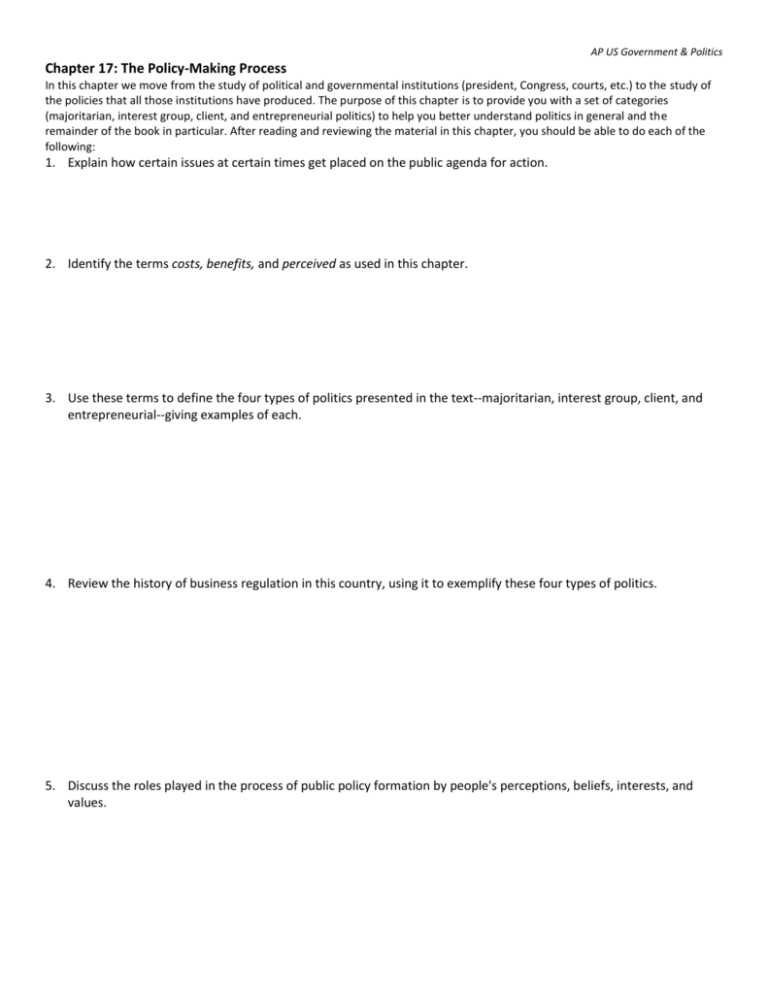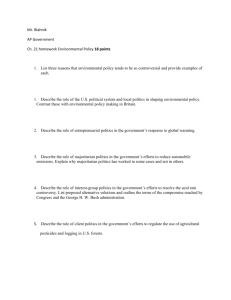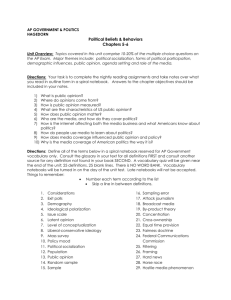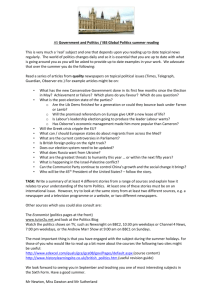AP US Government & Politics Chapter 17: The Policy
advertisement

AP US Government & Politics Chapter 17: The Policy-Making Process In this chapter we move from the study of political and governmental institutions (president, Congress, courts, etc.) to the study of the policies that all those institutions have produced. The purpose of this chapter is to provide you with a set of categories (majoritarian, interest group, client, and entrepreneurial politics) to help you better understand politics in general and the remainder of the book in particular. After reading and reviewing the material in this chapter, you should be able to do each of the following: 1. Explain how certain issues at certain times get placed on the public agenda for action. 2. Identify the terms costs, benefits, and perceived as used in this chapter. 3. Use these terms to define the four types of politics presented in the text--majoritarian, interest group, client, and entrepreneurial--giving examples of each. 4. Review the history of business regulation in this country, using it to exemplify these four types of politics. 5. Discuss the roles played in the process of public policy formation by people's perceptions, beliefs, interests, and values. AP US Government & Politics Chapter 18: Economic Policy The purpose of this chapter is to introduce you to an area of public policy that affects everyone in one way or another: economic policy. The chapter covers both the divided attitudes that voters have toward a "good" economy and the competing theories that economists offer on how to obtain a good economy. The various agencies that participate in formulating government economic policy are reviewed, along with the many stages of producing and implementing the annual federal budget. Finally, the controversial areas of government spending and tax reform are discussed. After reading and reviewing the material in this chapter, you should be able to do each of the following: 1. Show how voters have contradictory attitudes regarding their own and others' economic benefits. 2. List and briefly explain the four competing economic theories discussed in the chapter. 3. Assess the nature and effect of Reaganomics. 4. List the four major federal government agencies involved in setting economic policy, and explain the role of each. AP US Government & Politics 5. Analyze federal fiscal policy in terms of the text's four categories of politics. 6. Trace the history of federal government budgeting practices up to the present day. 7. Comment on the prospects and the desirability of lowering federal spending and reforming the income tax. AP US Government & Politics Chapter 19: Social Welfare This chapter covers more than fifty years of the political history of efforts to establish, maintain, expand, or cut those major programs that give or claim to give government help to individuals in need. After reading and reviewing the material in this chapter, you should be able to do each of the following: 1. Describe the goals of the American social welfare system, and contrast its programs with those of the British in terms of centralization. 2. Describe the major elements of the American system, including Social Security, Medicare, and AFDC programs. 3. Explain why some welfare policies can be considered majoritarian politics and others client politics. Give examples and indicate the political consequences of each. 4. Discuss recommendations to deal with the rising costs of Social Security and Medicare as well as the Welfare Reform Act of 1996. AP US Government & Politics Chapter 20: Foreign and Military Policy This chapter presents a survey of selected topics in United States foreign policy (or rather policies), focusing on the political processes involved in arriving at those policies. After reading and reviewing the material in this chapter, you should be able to do each of the following: 1. List the constitutional powers of the president and compare them with the authority of Congress in foreign affairs. Indicate why it is naive to read the Constitution literally in order to determine which institution has the major responsibility to conduct foreign policy. Explain why the president has a larger role than the Framers intended. 2. Compare the president's powers with those of a prime minister in a parliamentary system. 3. Explain why checks on the powers of the national government in foreign affairs are primarily political rather than constitutional. 4. Give reasons for the volatility of public opinion on foreign affairs. Explain the advantages that the president obtains when he acts resolutely in crises. Describe the problems that the president may face, using public opinion on the Vietnam War as an example. AP US Government & Politics 5. Explain the worldview concept, and describe the containment strategy of Mr. X. Summarize essential elements of the Munich-Pearl Harbor and post-Vietnam worldviews. Discuss the revisionist argument that it is the material interests of elites, rather than their principles, that explain American foreign policy. Indicate the potential objections to this view. 6. Analyze the key allocative decisions about the defense budget. List factors that make the decisions on the budget incremental. Explain how the congressional role in deciding on weapons systems has changed in recent years. 7. Explain how the condition of the defense industry makes necessary a follow-up system in the distribution of contracts. Indicate the extent to which client defense politics affects U.S. industry, and compare the performance of defense contractors with that of similar nondefense companies. 8. Explain why the cost-overrun problem is primarily the result of bureaucratic rather than political factors, and describe proposed reforms of the system. 9. Explain why the 1947 and 1949 Defense Reorganization Acts prevented the merger of services in the Defense Department. Review the current structure of the department, and explain how it contributes to interservice rivalries. Explain why presidents find it difficult to use the Joint Chiefs of Staff to control defense policy making. Discuss the reforms adopted in 1986. AP US Government & Politics Chapter 21: Environmental Policy Environmental policy, like economic or welfare policy, reflects the unique nature of the American political system. Unlike economic or welfare issues, however, environmental issues lend themselves to entrepreneurial politics, which requires mobilizing the media, dramatizing the issue, and convincing members of Congress that their political reputations will suffer if they do not cast the right vote. It is politics in which an unorganized public benefits at the expense of a well-organized group, such as a manufacturer. After reading and reviewing the material in this chapter, you should be able to do each of the following: 1. List three reasons environmental policy tends to be so controversial, providing examples of each reason. 2. Describe the role of the American political system and local politics in shaping environmental policy. Contrast these with environmental policy making in England. 3. Distinguish among the following styles of politics in terms of who benefits and who pays: entrepreneurial, majoritarian, interest group, and client. 4. Describe the role of entrepreneurial politics in government's efforts to deal with the issues of global warming and endangered species. 5. Outline the major provisions of the Clean Air Act (1970), the Water Quality Improvement Act (1970), the revised Clean Air Act (1990), and the National Environmental Policy Act (1969). AP US Government & Politics 6. Describe the role of majoritarian politics in government's efforts to reduce automobile emissions. Explain why majoritarian politics worked in some cases and not in others. 7. Describe the role of interest group politics in government's efforts to resolve the acid rain controversy. List proposed alternative solutions, and outline the terms of the compromise that was reached by Congress and the Bush administration. 8. Describe the role of client politics in government's efforts to regulate the use of agricultural pesticides and timber cutting in U.S. forests. 9. Give three reasons why it is so difficult to develop a sane environmental policy in this country. Provide examples of how the EPA is dealing with these problems. 10. Discuss the results of environmental protection measures that have been taken since 1970.








